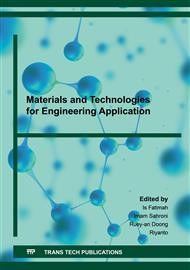[1]
D. Lakherwal, Adsorption of Heavy Metals: A Review, Int. J. Environ. Res. and Dev. 4 (2014) 41-48.
Google Scholar
[2]
Babel, S., and Kurniawan T.A. 2003. Low-Cost Adsorbents for Heavy Metals Uptake from Contaminated Water: A Review, J. Hazard Mater 97: 219-243.
DOI: 10.1016/s0304-3894(02)00263-7
Google Scholar
[3]
A. Kortenkamp, M. Casadevall, S.P. Faux, A.A. Jenner, R.O.J. Shayer, N. Woodbrige, and P. O'Brien, A role of molecular oxygen in the formation of DNA damage during the reduction of the carcinogen chromium (VI) by glutathione, Arch. Biochem. Biophys. 329 (1996) 199-208.
DOI: 10.1006/abbi.1996.0209
Google Scholar
[4]
B. Preeta and T. Viruthagiri, Biosorption of zinc (II) by Rhizopus arrhizus; equlibrium and kinetic modeling, African J. Biotechnol. 4 (2005) 506-508.
Google Scholar
[5]
S. Sumathi, S. Bhatia, Lee, and A.R Mohamed, Optimization of microporous palm shell activated carbon production for flue gas desulphurization: Experimental and statistical studies, Bioresour. Technol. 100 (2009) 1614-1621.
DOI: 10.1016/j.biortech.2008.09.020
Google Scholar
[6]
Y. Nasruddin, H.I. Naf'an, J. Sinto, and Y.W. Nugroho, Utilization of crown pineapple waste as raw material preparation of activated carbon ad adsorbent in natural gas storage. E3S Web of Conferences 67 (2018) 02018.
DOI: 10.1051/e3sconf/20186702018
Google Scholar
[7]
A.R. Hidayu, N.F. Mohamad., S. Matali., and A.S.A.K. Sharifah, Characterization of activated carbon prepared from oil palm empty fruit bunch using BET and FT-IR techniques, Procedia Engineering 68 (2013) 379-384.
DOI: 10.1016/j.proeng.2013.12.195
Google Scholar
[8]
E. Kusrini, A. Seyopratiwi, and U.M. Yahya, Preparation of selenium-doped activated carbon and its utilization for improving the quality of used coconut oil, J. Phys. Sci. 18 (2007) 11-21.
Google Scholar
[9]
A. Nayak, B. Bhushan, V. Gupta, and P. Sharma, Chemically activated carbon from lignocellulosic wastes for heavy metal wastewater remediation: Effect of activation conditions, J. of Colloid and Interface Sci. 493 (2017) 228-240.
DOI: 10.1016/j.jcis.2017.01.031
Google Scholar
[10]
Awitdrus, R. Juliani, E. Taer, R. Farma, Iwantono, and M. Deraman, Supercapacitor Electrodes Based on Corn Stalk Binderless Activated Carbon, IOP Conf. Series: J. Phys. 1120 (2018) 012005.
DOI: 10.1088/1742-6596/1120/1/012005
Google Scholar
[11]
R.M. Braga, T.S. Queiroga, G.Q. Calixto, H.N. Almeida, D.M.A. Melo, M.A.F. Melo, J.C.O. Freitas, and F.D.S. Curbelo, The energetic characterization of pineapple crown leaves, Environmental Science Pollutant Research 22 (2015) 18987-18993.
DOI: 10.1007/s11356-015-5082-6
Google Scholar
[12]
D. Prahas, Y. Kartika, N. Indraswati, and S. Ismadji, Activated carbon from jackfruit peel waste by H3PO4 chemical activation: pore structure and surface chemistry characterization, Chem. Eng. J. 140 (2008) 32-42.
DOI: 10.1016/j.cej.2007.08.032
Google Scholar
[13]
X. Duan, J. Peng, C. Srinivasakannan, L. Zhang, H. Xia, K. Yang, and Z. Zhang, Process optimization for the preparation of activated carbon from jatropha hull using response surface methodology, Energy Sources, Part A: Recovery, Utilization, and Environmental Effects 33 (2011) 2005-2017.
DOI: 10.1080/15567030903515047
Google Scholar
[14]
K.S. A. Al Shoaibi, and C. Srinivasakannan, Activated carbon from date palm seed: Process optimization using response surface methodology, Waste and Biomass Valorization 3 (2012) 149.
DOI: 10.1007/s12649-011-9104-4
Google Scholar
[15]
S. Gogoi, S. Chakraborty, and M.D. Saikia, Surface modified pineapple crown leaf for adsorption of Cr(VI) and Cr(III) ions from aqueous Solutions, J. Env. Chem. Eng. 6 (2018) 2492-2501.
DOI: 10.1016/j.jece.2018.03.040
Google Scholar
[16]
M.N. Mahamad, M.A.A. Zaini, and Z.A. Zakaria, Preparation and characterization of activated carbon from pineapple waste biomass for dye removal, International Biodeterioration and Biodegradation 102 (2015) 274-280.
DOI: 10.1016/j.ibiod.2015.03.009
Google Scholar
[17]
O.S. Bello and M.A. Ahmad, Adsorptive removal of a synthetic textile dye using coca pod husks, Toxicol Environmental Chemical 93 (2011) 1298-1308.
DOI: 10.1080/02772248.2011.590490
Google Scholar
[18]
C. Xiong, Y. Zheng, Y. Feng, C. Yao, C. Ma, X. Zheng, and J. Jiang, Preparation of a novel chloromethylated polystyrene-2-amino-1,3,4-thiadiazole chelating resin and its adsorption properties and mechanism for separation and recovery of Pt(IV) from aqueous solutions, J. Mater Chem. 2 (2014) 5379-5386.
DOI: 10.1039/c3ta14923d
Google Scholar
[19]
O. Hayet and N.H.G. Batis, Removal of Cd(II) from Phosphoric Acid Solution by Adsorbents: Equilibrium and Kinetic Studies, Chemical Science Transactions 2 (2013) 357-366.
DOI: 10.7598/cst2013.285
Google Scholar
[20]
C.K. Lim, H.B. Hui, H.N., A. Aris, Z.A. Majid, and Z. Ibrahim, Application of zeolite-activated carbon macrocomposite for the adsorption of Acid Orange 7: isotherm, kinetic and thermodynamic studies, Environmental Science Pollutant Resource 20 (2013) 7243-7255.
DOI: 10.1007/s11356-013-1725-7
Google Scholar


